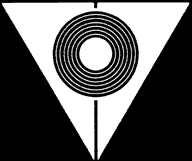of the
MCA Disco-Vision
System
by Kent D. Broadbent

Presented on 26 April 1974 at the 115th SMPTE Technical
Conference and Equipment Exhibit in Los Angeles, California.
Kent D. Broadbent, Vice President of MCA Disco-vision, Inc.,
is director of MCA's video disc research program.
MCA Disco-Vision is a system which records audio-video information on a disc, replicates this disc accurately and inexpensively on plastic and finally plays the replicas on home television screens by means of a disc player attachment. The production of a video record begins with a mastering process where the original program from any video source is recorded in real time as a geometrical pattern on the master disc. After mastering, this pattern is reproduced in the various replication steps leading to the production of multiple inexpensive plastic video records. Specifically, the mastering process uses a laser beam to cut holes in the coating of a master disc and thereby record information. After processing, this master is used to produce replica playback discs. The player reads the information on the playback disc by sensing the reflection of a 1 milliwatt laser beam and recreating an electrical signal corresponding to the original information. This signal is then used to modulate an RF carrier on an unused TV channel and this modulated signal is connected to the TV set where it is processed within the set in the usual manner to produce a color picture and sound. |
| ACKNOWLEDGEMENT The techniques reported in this review are the result of developments carried out by Department Heads John Winslow, James E. Elliott, and Ray Dakin, and their associates on the MCA Laboratories staff. |
| MCA LABORATORIES MCA DISCO-VISION, INC. 1640 4VEST 228TH STREET, TORRANCE, CALIFORNIA 90501 (213) 534-2821 |
Important: It is worth noting that this paper was written and presented during the very early developmental stages of what is now known as LaserDisc. There are technical variances and fundamental shifts in what we are using today as LaserDisc players and what was originally shown at this technical conference during the early spring of 1974. While some of what is contained in this paper still applies to today's LaserDisc technology, much of what you are about to read was changed during the 4 year period between the authoring of this paper and the introduction of DiscoVision in December 1978. |